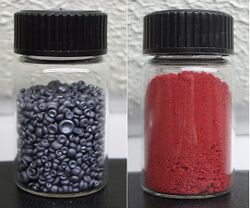Selenium, 34 Selenium Pronunciation (sil-EE -nee-əm Appearance grey metallic-looking, red, and vitreous black (not pictured) allotropes Standard atomic weight A r, std (Se) [1] Selenium in the periodic table
Atomic number (Z ) 34 Group group 16 (chalcogens) Period period 4 Block p-block Element category p-block , sometimes considered a metalloid Electron configuration [Ar ] 3d10 4s2 4p4 Electrons per shell 2, 8, 18, 6 Physical properties Phase at STP solid Melting point 494 K (221 °C, 430 °F) Boiling point 958 K (685 °C, 1265 °F) Density (near r.t. ) gray: 4.81 g/cm3 3 3 when liquid (at m.p. ) 3.99 g/cm3 Critical point 1766 K, 27.2 MPa Heat of fusion gray: 6.69 kJ/mol Heat of vaporization 95.48 kJ/mol Molar heat capacity 25.363 J/(mol·K) Vapor pressure
P (Pa)
1
10
100
1 k
10 k
100 k
at T (K)
500
552
617
704
813
958
Atomic properties Oxidation states −2 [2] +2 +4 +6 acidic oxide)Electronegativity Pauling scale: 2.55 Ionization energies 1st: 941.0 kJ/mol 2nd: 2045 kJ/mol 3rd: 2973.7 kJ/mol Atomic radius empirical: 120 pm Covalent radius 120±4 pm Van der Waals radius 190 pm Spectral lines of seleniumOther properties Natural occurrence primordial Crystal structure hexagonal Speed of sound thin rod 3350 m/s (at 20 °C) Thermal expansion amorphous: 37 µm/(m·K) (at 25 °C) Thermal conductivity amorphous: 0.519 W/(m·K) Magnetic ordering diamagnetic [3] Magnetic susceptibility −25.0·10−6 cm3 /mol (298 K)[4] Young's modulus 10 GPa Shear modulus 3.7 GPa Bulk modulus 8.3 GPa Poisson ratio 0.33 Mohs hardness 2.0 Brinell hardness 736 MPa CAS Number 7782-49-2 History Naming after Selene , Greek goddess of the moon Discovery and first isolationJöns Jakob Berzelius and Johann Gottlieb Gahn (1817)Main isotopes of selenium
Category: Selenium view · talk · edit references
Se
data m.p. cat
C
221
—
—
K
494
494
0
F
430
430
0
max precision
0
WD
input
C: 221, K: 494, F: 430
comment
Se
data b.p. cat
C
685
—
—
K
958
958
0
F
1265
1265
0
max precision
0
WD
input
C: 685, K: 958, F: 1265
comment
References These references will appear in the article, but this list appears only on this page.
↑ Meija, Juris; Coplen, Tyler B.; Berglund, Michael; Brand, Willi A.; De Bièvre, Paul; Gröning, Manfred; Holden, Norman E.; Irrgeher, Johanna et al . (2016). "Atomic weights of the elements 2013 (IUPAC Technical Report)". Pure and Applied Chemistry 88 (3): 265–91. doi :10.1515/pac-2015-0305 . ↑ Greenwood, Norman N. ; Earnshaw, Alan (1997). Chemistry of the Elements (2nd ed.). Butterworth-Heinemann . ISBN 978-0-08-037941-8 . ↑ Magnetic susceptibility of the elements and inorganic compounds , in Lide, D. R., ed (2005). CRC Handbook of Chemistry and Physics (86th ed.). Boca Raton (FL): CRC Press. ISBN 0-8493-0486-5 . ↑ Weast, Robert (1984). CRC, Handbook of Chemistry and Physics . Boca Raton, Florida: Chemical Rubber Company Publishing. pp. E110. ISBN 0-8493-0464-4 . Template:Documentation


